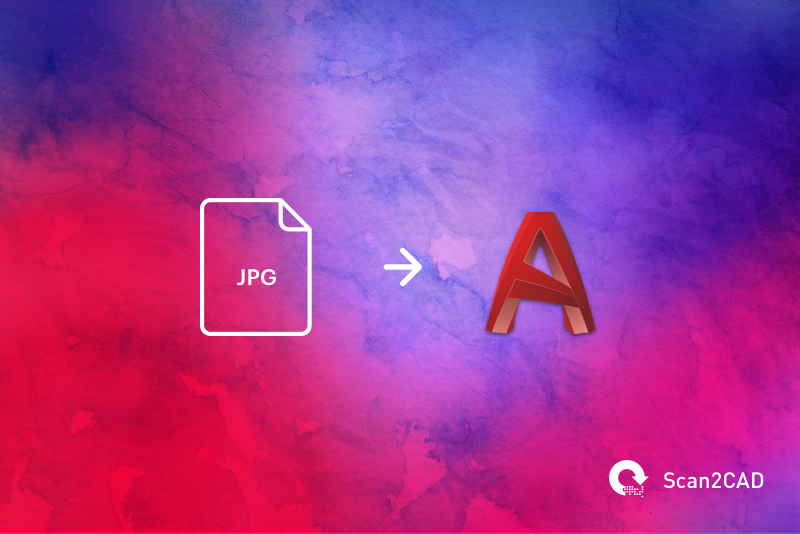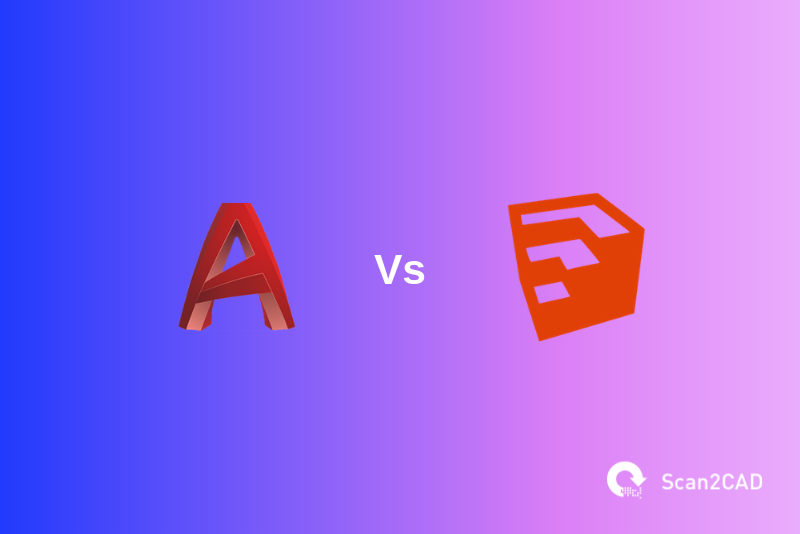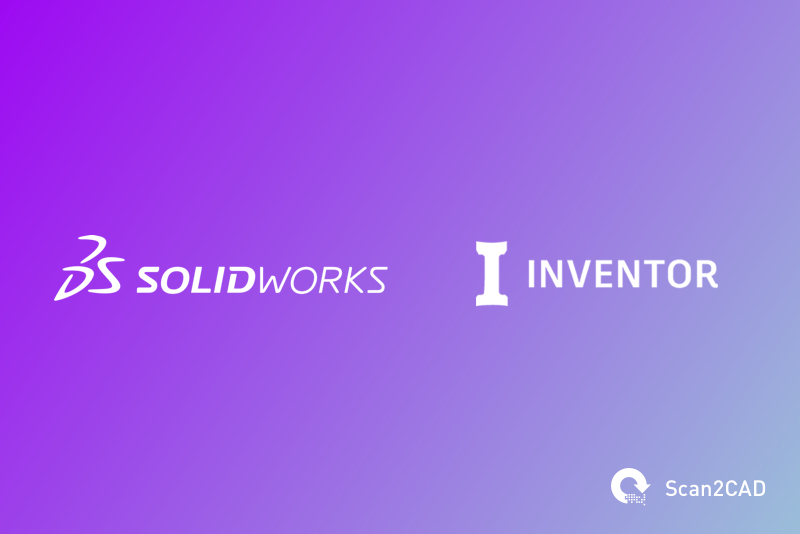Due to the number of CAD (Computer-Aided Design) software packages available today, it can be quite confusing when selecting the appropriate package for your application. There are numerous CAD programs with either similar or varying features, developed by various companies, for different industries. To make the selection process easy for you, we at Scan2CAD, regularly provide comparison articles on different CAD software packages.
Typically, we compare products from different companies. In this article, however, we will be comparing two popular products from the same company. Autodesk is one of the oldest and most popular CAD software companies, and we will be comparatively looking at the histories, features, and uses of two of their most ubiquitous programs, AutoCAD and Inventor.
Table of Contents
AutoCAD

The names interact CAD and MicroCAD are virtually unknown in the world of CAD today. However, these were the names that AutoCAD bore in the late 1970s. In 1982, AutoCAD as we know it was developed by Michael Riddle alongside 15 other co-founders, and released as the flagship product of Autodesk, the company which they founded that same year. The release of AutoCAD completely revolutionized the CAD industry. First of all, being one of the first CAD programs to run on PCs, AutoCAD instantly made CAD accessible to a lot of designers. Before this, most individual designers had to rely on the error-prone drafting desk and T-square, as commercially available CAD applications could only run on mainframe and minicomputers. Also, the popular and widely accepted DWG file format was developed for AutoCAD. It took the application just four years to become the most widely used CAD application; a status which it still holds today. AutoCAD 2020, the latest version of the software package, was released in 2019, marking the 34th release.
What does AutoCAD do?
Initially developed as a 2D drafting program for mechanical engineers, AutoCAD has expanded to become a complete package for most things design and modeling. It now includes features that cater to numerous industries that are related to design and engineering.
In addition to AutoCAD, Autodesk developed several industry-specific AutoCAD products. These include AutoCAD Architecture, AutoCAD Plant 3D, AutoCAD Mechanical, AutoCAD MEP (Mechanical, Electrical, and Plumbing), and AutoCAD Electrical. In 2019, however, all these products were brought together as AutoCAD toolsets under a single comprehensive software package.
There is also an entry-level, lite version of the AutoCAD known as AutoCAD LT. This Lite version is less expensive and has less functionality than AutoCAD. There is also AutoCAD for students, a free limited version to help students learn CAD.
AutoCAD classic
This is the classic AutoCAD interface which allows you to design 2D drafts, produce 3D models, annotate drawings, and share file data
AutoCAD Architecture
As the name implies, the Architecture toolset is for the architecture industry. Using this toolset, you can produce and document architectural designs, and also automate drafting tasks. Features available include walls, windows, and doors. Specialized tools enable architects to create building drawings such as floor plans, elevations, and sections.
AutoCAD architecture has a library of 8000+ architectural components.
AutoCAD Mechanical
This toolset is dedicated to DFM (Design For Manufacturing). Its features help you create, modify, and document mechanical designs for manufacturing. They also enable you to automate mechanical engineering processes such as dimensioning, generating machine parts, and creating bills of material.
Instead of designing every component you require from scratch, you can significantly reduce your design efforts by using components from the AutoCAD mechanical library of over 700,000 parts and symbols.
AutoCAD Electrical
This toolset consists of features for electrical designs, that enable you to create, modify, and document electrical circuits and control systems. Electrical drawings like schematic diagrams are achievable using specialized tools. Your drawings are organized in a project-based structure, in line with project standards.
The Electrical toolset includes a library of 65,000+ electrical symbols which, conform to various standards.
AutoCAD Plant 3D
The plant 3D toolset enables you to design 2D and 3D piping and instrumentation diagrams which you can incorporate into a 3D plant model. To make it easy for you to design highly complex pipe routing and plant designs, this toolset comes with a library of more than 400 plant components such as equipment templates, support templates, and structural members.
AutoCAD MEP
The MEP toolset is for creating and documenting MEP drawings for buildings using a library of more than 10,500 MEP components. It is often used alongside the Architecture toolset for complete building design.
Who uses AutoCAD?
Due to various features and toolsets present in AutoCAD, the application is used across various industries. It has something for most professionals that are concerned with design and engineering. Some of the professions that employ AutoCAD are mechanical engineers, automobile engineers, manufacturers, landscape designers, structural engineers, interior designers, architects, plant engineers, production engineers, chemical engineers, industrial engineers, electrical engineers, electricians, plumbers, MEP engineers, quantity surveyors, cartographers, and mapping/topology experts.
Inventor

The first version of Inventor was released in 1999, 17 years after the release of the first version of AutoCAD. It was originally authored by Jacob Sain and developed by Autodesk. Between 1999 and 2003, nine versions of the software were released sporadically. The annual release of the software began in 2004 and continues today. In total, 25 versions have been released, the latest being Inventor 2020. Over the years, several improvements have transitioned the software from an ordinary to a highly advanced CAD program.
What does Inventor do?
Autodesk Inventor is a professional-grade 3D mechanical design, documentation, visualization, and simulation CAD software package. You can use this application to create 3D parts and assemblies, build and analyze complete systems, and developed DWG file drawings for assembly or fabrication.
Inventor’s features can be classified into product design, modeling, simulation, visualization, design automation, and collaboration.
Product design features are applied chronologically in the creation of parts, assemblies, and drawings. These involve the use of shape generators, as well as, parametric modeling, assembly modeling and drawing creation tools.
Modeling features allow you to create complex 3D mechanical and sheet metal designs through flexible modeling, direct modeling, free form modeling, and importation of files. There are also component libraries, component generators, tube and pipe design tools, and plastic parts design tools.
Using the advanced simulation features of Inventor, you can carry out stress analysis on parts or entire products, and also apply forces to study the motion, speed, and acceleration of your model.
Visualization and rendering features allow you to view your model in various ways. You can easily create exploded views and animations of complex assemblies. Also, you can view the real-life appearance of your model using rendering tools.
Collaboration and data management features allow you to share your design for review and comment easily. You can also store your designs in a vault, making it easy to search for, find, and copy design files.
In summary, Inventor has the following uses; 3D medical design, electrical systems design, sheet metal design, tube and pipe design, design documentation, simulation, visualization, data management, and collaboration.
Who uses Inventor?
It is safe to assume that Autodesk‘s popularity helps promote the wide acceptance of Inventor. However, it is the application’s impressive capabilities and advanced functionality that make it indispensable to engineers and designers across various industries. These industries include manufacturing, production, construction, sports, medicine, fashion, automotive, and aerospace industries.
The following are examples of companies that employ Inventor in their production processes. Granta uses it to create custom skull implants for victims of head trauma, Flo cycling employs it to create efficient bike wheels, Lightning Motorcycle applies it to design superbikes, Can Lines Engineering designs conveyor lines for the production of canned beer, Pacific Northern creates custom jewelry displays using the application, Ausis Technology creates in-ear monitoring technology for musicians on stage, Airbus develops cabin partitions for planes, and Advanced Solution uses the software to design and develop 3D printed organs. Many other companies are using Inventor to change the world.
AutoCAD Vs Inventor
|
AutoCAD |
Inventor |
|
Used for 2D drafting and 3D modeling |
Used for 3D part and assembly modeling, analyzing mechanical systems, simulation, visualization, analysis, and collaboration |
|
Geometry-driven |
Parametric and design-driven |
|
Includes industry-specific features for architecture, production, manufacturing, construction, and electrical industries |
Has features dedicated to mechanical design and manufacturing, with aspects of electrical design |
|
Used by MEP engineers, electrical engineers, architects, civil engineers, cartographers, and mechanical engineers |
Used mainly by designers, mechanical engineers, and manufactures |
|
Creates files in the DWG file format only |
Creates files in IPT (part), IAM (assembly), IDW (drawing), and IPJ (project) file formats. Also compatible with DWG |
|
Has a steep learning curve due to its plethora of features |
Relatively easier to learn with a user-friendly GUI (Graphical User Interface) |
|
Works on both Mac and Windows |
Works only on Windows |
|
Available as both single-user and multi-user licenses |
Available as a single-user license |
|
Costs $1,610/year |
Costs $1,985/year |
AutoCAD is best suited for industry professionals seeking to create 3D models and 2D drafts. Inventor, on the other hand, is specifically for designers and engineers who create parts, assemblies, and drawings with manufacturing and production in mind. Both AutoCAD and Inventor have 30-day trial versions so you can explore them to get personal experience before deciding which is best for you.




